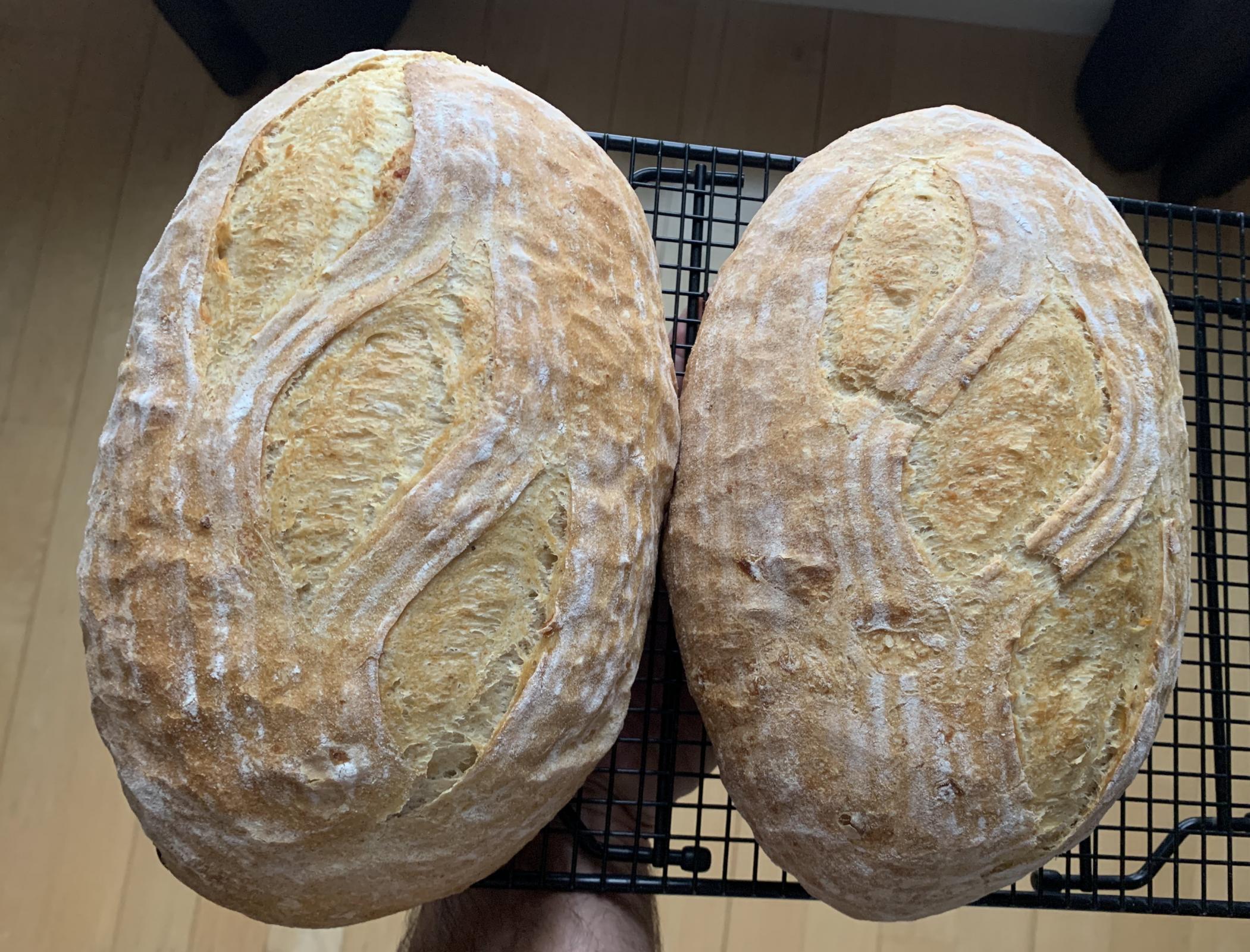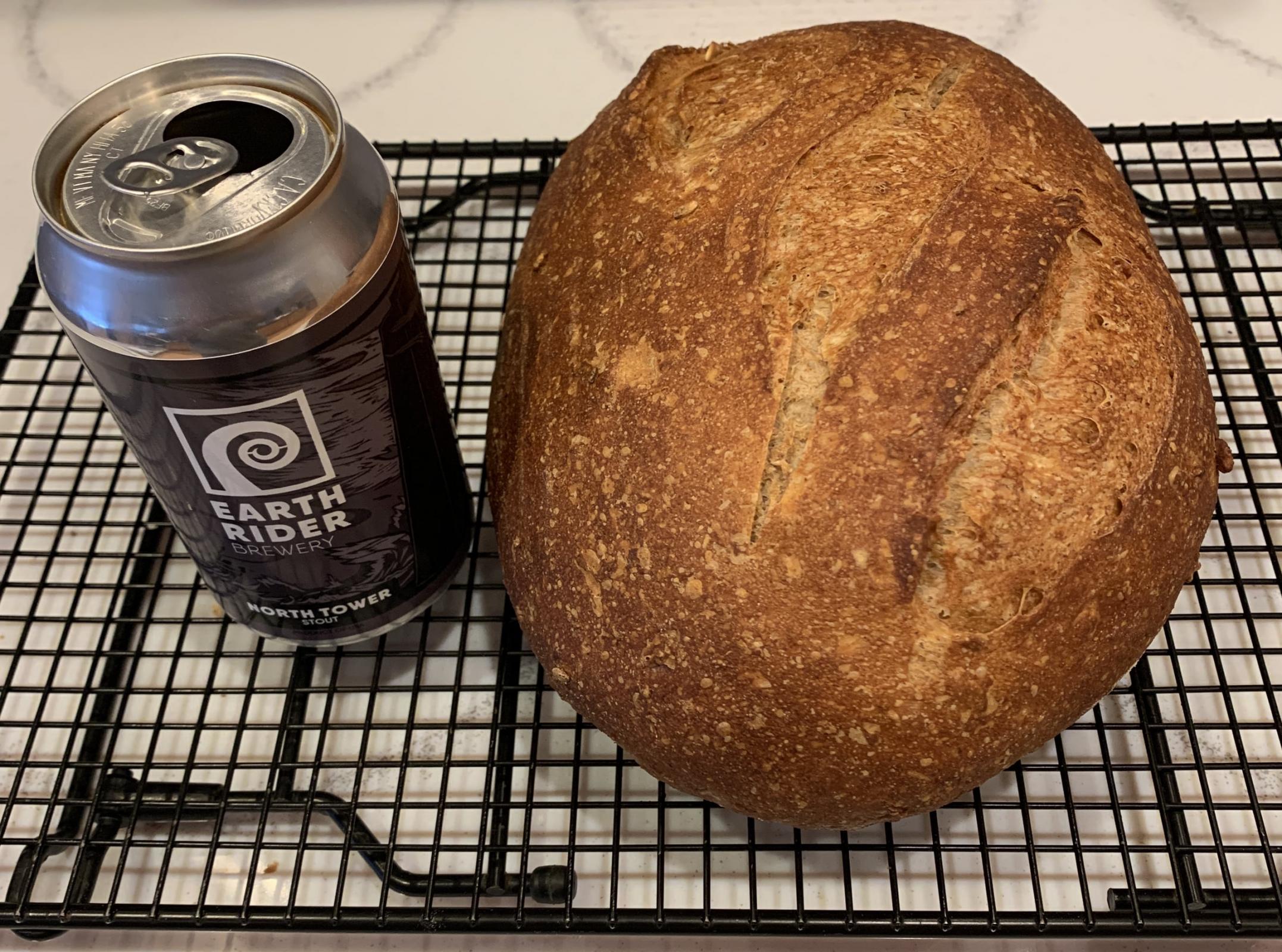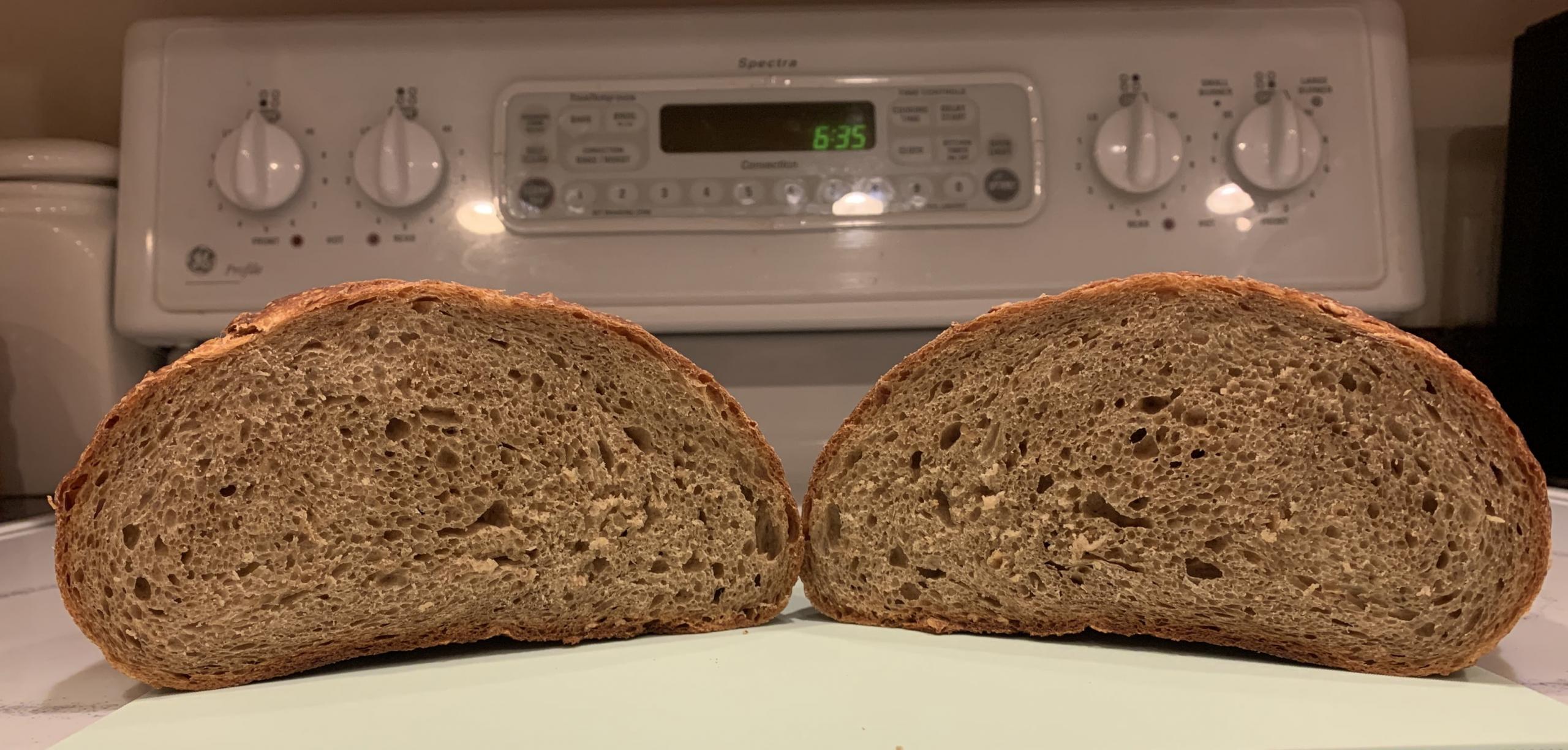Carmelized Golden Potato Bread
The basis for this bake is Hamelman’s Roasted Potato Bread from Bread (2nd Ed.). This is my second time making it with two tweaks that I thought were minor (but turned out to be a big difference) and also baked at a lower temp this time. I followed the recipe verbatim the first time I made it and used Mr. Hamelman’s suggestion of oven roasting the potatoes. The bread turned out very good.
This time, I wanted to see if I could bring out the flavor of the potato a little more and also wanted to use a little bit of yeast water in the pate fermente instead of just ADY. I prepared the potatoes using my favorite way of having them: pan fried in butter. However, instead of using a medium heat and browning/crisping the potatoes, I used a low heat with a covered pan for 90 minutes (turning them every 30 minutes). With that, the potatoes became more carmelized than fried.
Whether it was the difference in potato prep or use of the RYW I can’t say for sure (leaning towards potato prep), but the dough was almost uncontrollable. While going through the same procedure of bowl kneading, the dough was already starting to take off. After going to bulk, it rose 2.5-3x in 30 minutes. I punched it down aggressively and pre-shaped, but in hind sight, I should have let it double again. By the end of the 15-minute bench rest, the surface of the doughs were already bubbling. I degassed aggressively again during final shape, but they were almost overflowing the bannetons after 45 minutes at 74-75 deg F.
The first time I made the bread, the bottom crust was on the verge of burning from the potato starches (450 deg F during steaming), so this time, I dropped the temps during baking. Bottom crusts looked great, but I would have liked to get a little more color in the top crusts. That being said, this bread is one of the most tender and soft I’ve made to-date (based on squeezing the loaves while bagging them) and had a nice potato aroma! All these loaves were spoken for, but a friend did send a crumb shot. Bit of a bad angle. Overall, I think it looks OK but it was unfortunate seeing the large holes. Not sure if that was the rapid rising or if I didn't fully degas before the final shaping.
SIDE NOTE: I was shocked how "yellow" the soft white bulbs in our kitchen make everything until I turned them off to try and get an overhead photo without shadows of me in it. Same photo below with lights on and off.
Makes 4 loaves…
Pate Fermente
480g Bread Flour
160g Raisin Yeast Water
153.6g Water
9.6g Sea Salt
0.5g Active Dry Yeast
Final Dough
800g All Purpose Flour
80g Bread Flour
240g Whole Wheat Flour
662.4g Water (may need to add more depending on residual moisture from potatoes)
28.8g Sea Salt
24.5g Active Dry Yeast
Add-Ins
400g Yellow (Gold) Potatoes
12g Butter
Method
The night before
1) Prepare pate fermente by combining all ingredients and lightly knead until smooth. Place in covered bowl and ferment for 12-14 hours at 70-72 deg F
The next morning
1) Cut potatoes into small cubes and place in covered frying pan with butter on low heat. Make sure heat is low enough to not brown the potatoes. Stir ever 20-30 minutes to cook evenly. Let cool after 90 minutes and then mash them with a fork.
2) Add 150g of water to the potatoes and mix thoroughly to create a loose mashed potato consistency.
3) Dissolve yeast in remaining water.
4) Combine all ingredients including salt and start to mix. Add chunks of pate feremente while mixing to incorporate it. Mix until flours are wetted. Adjust hydration if needed.
5) Fermentolyse for 20 minutes
6) Perform 4 sets of bowl kneading with 10-minute rests between sets.
7) Bulk ferment at 76 deg F until dough has doubled
8) Punch down dough and pre-shape into boule
9) Bench rest for 15-20 minutes
10) Final shape as oval and place in banneton with seam side up
11) Final proof at 76 deg F
12) Pre-heat oven at 425 deg F. Place doughs on oven steel with steam pan on bottom rack. Bake at 425 deg F (5 minutes); reduce heat and bake at 400 deg F (15 minutes); vent oven; reduce heat and bake at 375 deg F (15 minutes)




North Tower Oatmeal Stout Sourdough
The basis for this bake is the recipe Beer Bread from Bread (2nd Ed.). I also added a rolled oats/stout soaker. For the beer, I used North Tower Stout by Earth Rider Brewery.
Rye Sour
44g Fresh Milled Whole Rye
36.5g Water
2.2g Mature Sourdough Culture (I used my White Flour starter)
Liquid Levain
40g Bread Flour
50g Water
8g Mature Sourdough Culture (I used my White Flour starter)
Final Dough
200g All Purpose Flour
80g Bread Flour
16g Fresh Milled Whole Rye
20g Whole Wheat Flour
100g Stout
85.5g Water
8g Sea Salt
1.4g Active Dry Yeast
Soaker
40g Rolled Oats
60g Stout
Method
The night before…
1) Prepare rye sour and ferment for 12-14 hours at 70-72 deg F
2) Prepare the liquid levain and ferment for 12-14 hours at 70-72 deg F
3) Combine soaker ingredients in a covered bowl and refrigerate
The next morning…
4) Dissolve yeast in water
5) Combine all ingredients including soaker, rye sour, liquid levain, and salt. Mix until flours are wetted.
6) Fermentolyse for 30 minutes
7) Perform four sets of bowl kneading to develop gluten with 10-minute rests between sets
8) Bulk ferment in oiled bowl at 76 deg F.
9) Stretch and Fold at 45-minute intervals until dough is getting “puffy”. Should be 1 or 2 folds.
10) Bulk ferment until dough has increased roughly 75-85%.
11) Degas and pre-shape into a boule
12) Bench rest for 15-20 minutes
13) Final shape in an oval and place in a banneton
14) Final proof at 76 deg F until dough has doubled.
15) Pre-heat oven at 460 deg F with steam pan on bottom rack
16) Place dough on baking steel and pour ¾ cup boiling water in steam pan
17) Reduce heat and bake at 450 deg (20 minutes); vent oven; reduce heat and bake at 425 deg F (15 minutes)




Discard Chocolate Chip Cookies
Refreshed my starter this weekend and didn’t want to waste the discard. Followed the recipe in Sourdough Cookbook for Beginners from Breadtopia. I like this recipe. The sourdough and the whole grain seem to take the edge off the sweetness of a chocolate chip cookie and they are not greasy at all.
Amounts are for a ½ batch. Makes 10 large cookies (used ¼ cup dough per cookie)
100g All Purpose Flour (for 100% hydration discard. Adjust as needed)
40g Whole Rye Flour
35g Whole Wheat Pastry Flour (can leave this out and use 125g AP and 50g rye)
50g sourdough discard
½ tsp baking soda
½ tsp salt
114g butter (softened)
½ tsp vanilla extract
80g brown sugar (I used dark brown)
70g granulated sugar
1 egg
170g semisweet chocolate chips
Method
1) Combine flours, baking soda, and salt and whisk together. Set aside
2) In a separate bowl, beat butter, sugars, discard, and vanilla extract until creamy (I used a stand mixer with paddle attachment)
3) Add egg and mix on medium speed until fully incorporated
4) Slowly add flour mixture until fully combined
5) Fold chocolate chips into dough and mix evenly
6) Cover bowl and place in refrigerator for at least 30 minutes to hydrate flours and make dough easier to handle
7) Pre-heat oven to 350 deg F
8) Place ¼ cup scoops of dough on parchment lined baking sheet. Space evenly on the sheet.
9) Bake in center oven rack position for 12-14 minutes or until bottoms are just starting to turn brown and no wet looking dough on their surface
10) Remove from oven and let sit for 2 minutes before placing on a cooling rack until fully cooled
